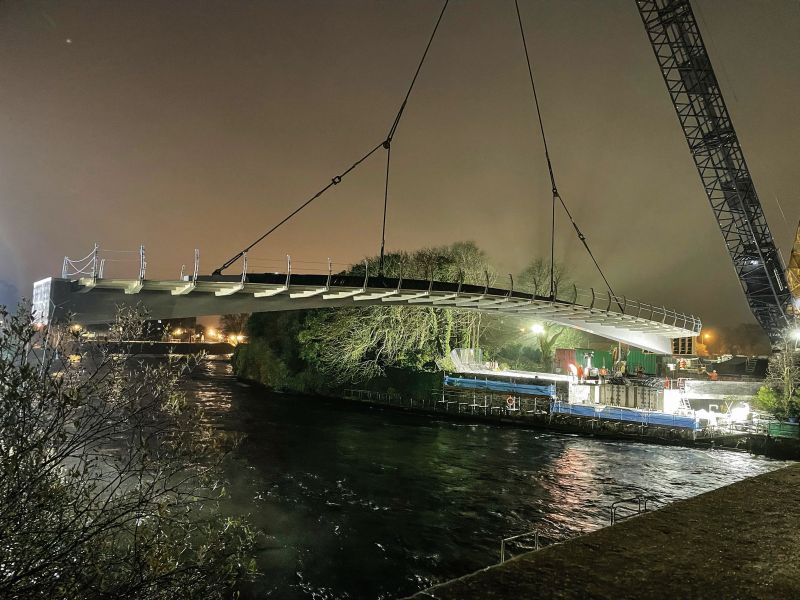CITY TRIBUNE
Parking fines: Galway City Council accused of focusing on raising revenue

Cosáin, a local cycling and pedestrian safety group, is claiming Galway City Council’s parking enforcement is mostly concerned with raising revenue rather than punishing or deterring illegal and obstructive parking.
The group’s spokesperson, Simon Comer, levelled the charge after analysing the past two years of Fixed Charge Penalty Notices (FCPN) issued by community wardens.
Uinsinn Finn, senior engineer, told the latest Joint Policing Committee meeting that there had been an increase in the number of parking fines issued by the City Council last year.
Mr Finn indicated to the meeting that the increase in fines issued may be related to the introduction of parking charges on Sundays at Council car parks, and the subsequent extra enforcement on the seventh day of every week.
However, Cosáin has supplied figures to the Galway City Tribune showing a substantial number of the fines issued relate to revenue-raising offences, as opposed to parking in locations where it is illegal to park.
Reports into the number of tickets issued by offence were released to Cosáin following a Freedom of Information (FOI) request.
They show that the total number of parking tickets issued by the City Council increased by 9% in 2017 compared with the previous year.
In 2016, some 14,123 FCPN were issued. That increased by around 1,300 to 15,429 in 2017.
Cosáin has pointed out that a considerable chunk of the tickets are not related to illegal parking that is causing an obstruction, and are “revenue-raising offences”.
Some 40% of all tickets issued by the City Council last year were for two offences that Cosáin says are mainly concerned with raising money to boost the local authority’s coffers.
A total of 2,603 tickets were issued for the offence of “parking a vehicle in a space in which a parking is subject to the payment of fees without displaying a valid parking disc”. A further 3,579 tickets were issued for “failing to display a current tax disc”.
For comparison, some 1,597 tickets were issued last year for “parking a vehicle on double yellow lines”; and 847 were issued for “parking a vehicle wholly or partly on a footpath”.
Mr Comer said: “A vehicle may be in a legal parking space but the Motor Tax disc may be invalid. The Council’s stats typically show that a substantial proportion of ‘parking’ fines are not for parking in illegal locations but for Motor Tax offences or for having invalid parking discs where a fee has to be paid. This could include, for example, parking in one of the City Council’s Pay & Display areas but having an expired disc.
“In other words, much of the Council’s ‘parking’ control effort is aimed primarily at revenue collection, through fines and fees. This is why the Council rarely, if ever, tries to control parking chaos around schools, keep the bike lanes clear or free the footpaths in residential areas. Their priorities lie elsewhere.”
Meanwhile, at the JPC meeting, Superintendent Marie Skehill in a written response to City Councillor Frank Fahy (FG) said Gardaí had issued a total of 229 Fixed Charge Notices during January and February of this year.
The Garda FCPN are separate and in addition to the Council’s figures.
CITY TRIBUNE
Galway ‘masterplan’ needed to tackle housing and transport crises

From the Galway City Tribune – An impassioned plea for a ‘masterplan’ that would guide Galway City into the future has been made in the Dáil. Galway West TD Catherine Connolly stated this week that there needed to be an all-inclusive approach with “vision and leadership” in order to build a sustainable city.
Deputy Connolly spoke at length at the crisis surrounding traffic and housing in Galway city and said that not all of the blame could be laid at the door of the local authority.
She said that her preference would be the provision of light rail as the main form of public transport, but that this would have to be driven by the government.
“I sat on the local council for 17 years and despaired at all of the solutions going down one road, metaphorically and literally. In 2005 we put Park & Ride into the development plan, but that has not been rolled out. A 2016 transport strategy was outdated at the time and still has not been updated.
“Due to the housing crisis in the city, a task force was set up in 2019. Not a single report or analysis has been published on the cause of the crisis,” added Deputy Connolly.
She then referred to a report from the Land Development Agency (LDA) that identified lands suitable for the provision of housing. But she said that two-thirds of these had significant problems and a large portion was in Merlin Park University Hospital which, she said, would never have housing built on it.
In response, Minister Simon Harris spoke of the continuing job investment in the city and also in higher education, which is his portfolio.
But turning his attention to traffic congestion, he accepted that there were “real issues” when it came to transport, mobility and accessibility around Galway.
“We share the view that we need a Park & Ride facility and I understand there are also Bus Connects plans.
“I also suggest that the City Council reflect on her comments. I am proud to be in a Government that is providing unparalleled levels of investment to local authorities and unparalleled opportunities for local authorities to draw down,” he said.
Then Minister Harris referred to the controversial Galway City Outer Ring Road which he said was “struck down by An Bord Pleanála”, despite a lot of energy having been put into that project.
However, Deputy Connolly picked up on this and pointed out that An Bord Pleanála did not say ‘No’ to the ring road.
“The High Court said ‘No’ to the ring road because An Bord Pleanála acknowledged it failed utterly to consider climate change and our climate change obligations.
“That tells us something about An Bord Pleanála and the management that submitted such a plan.”
In the end, Minister Harris agreed that there needed to be a masterplan for Galway City.
“I suggest it is for the local authority to come up with a vision and then work with the Government to try to fund and implement that.”
CITY TRIBUNE
Official opening of Galway’s new pedestrian and cycle bridge

The new Salmon Weir pedestrian and cycle bridge will be officially opened to the public next Friday, May 26.
Work on the €10 million bridge got underway in April 2022, before the main structure was hoisted into place in early December.
A lunchtime tape-cutting ceremony will take place on Friday, as the first pedestrians and cyclists traverse the as-yet-unnamed bridge.
The Chief Executive of Galway City Council, Brendan McGrath, previously said the bridge, once opened, would remove existing conflicts between pedestrians, cyclists and traffic “as well as facilitating the Cross-City Link public transport corridor over the existing 200-year-old bridge”.
The naming of the new bridge has been under discussion by the Council’s Civic Commemorations Committee since late last year.
One name that has been in the mix for some time is that of the first woman in Europe to graduate with an engineering degree – Alice Perry.
Ms Perry, who was from Wellpark, graduated from Queen’s College Galway (now University of Galway) in 1906. The university’s engineering building is named in her honour.
The bridge was built by Jons Civil Engineering firm in County Meath and was assembled off-site before being transported to Galway. Funding for the project was provided in full by the National Transport Authority and the European Regional Development Fund.
(Photo: Sheila Gallagher captured the city’s new pedestrian footbridge being raised on the south side of the Salmon Weir Bridge in December. It will officially open next Friday, May 26).
CITY TRIBUNE
Minister branded ‘a disgrace’ for reversing land rezoning in Galway City

From the Galway City Tribune – Minister of State for Local Government and Planning, Kieran O’Donnell was labelled a “disgrace” for overturning councillors’ decisions to rezone land in the new City Development Plan.
Minister O’Donnell (pictured) confirmed in a letter to Council Chief Executive Brendan McGrath last week that he was reversing 25 material alternations made by councillors to the CDP 2023-29. He made the decision on the advice of Office of Planning Regulator (OPR).
Minister O’Donnell directed that 14 land parcels that were subject to land-use zoning changes by councillors as part of the Material Alterations to the Draft CDP should be reversed.
He directed that a further 11 land parcels in the city should become “unzoned”.
The Minister found that the CDP had not been made in a manner consistent with recommendations of the OPR, which required specific changes to the plan to ensure consistency with the national planning laws and guidelines.
At last week’s Council meeting Cllr Eddie Hoare (FG) asked for clarity on the process by which councillors could rezone the lands that had been changed by the Minister’s direction.
Cllr Declan McDonnell said, “What he [Minister O’Donnell] has done is an absolute disgrace”.
And he asked: “Do we have to have another development plan meeting to deal with it?”
Both Cllrs Hoare and McDonnell wondered what would become of the lands that were rezoned or unzoned by the ministerial direction.
Mr McGrath said the Council had put forward an argument in favour of retaining the material alterations in the plan, but ultimately the Minister sided with OPR.
He said if councillors want to make alterations to the new plan, they could go through the process of making a material alteration but this was lengthy.
The Save Roscam Peninsula campaign welcomed the Minister’s decision.
In a statement to the Galway City Tribune, it said the direction would mean the Roscam village area on the Roscam Peninsula will be unzoned and a number of land parcels would revert back to agriculture/high amenity.
A spokesperson for the campaign said: “the material alterations made by city councillors following lobbying by developers continued the long-standing practice of councillors facilitating a developer-led plan rather than an evidence- and policy-based plan that meets the needs of the city.
“The Minister’s direction is an important step in restoring confidence in the planning system. It is clear from the City Council’s own evidence on future housing projections that there was no requirement to zone these lands for residential purposes in order to meet the needs of the targeted population increase up to 2029,” the spokesperson added.















